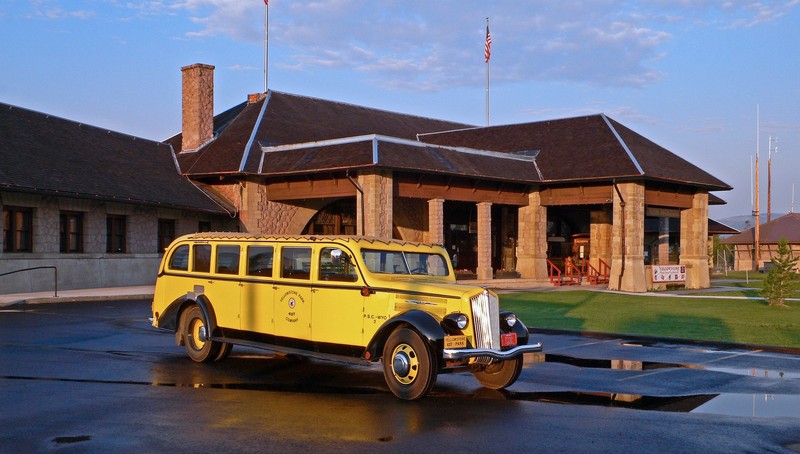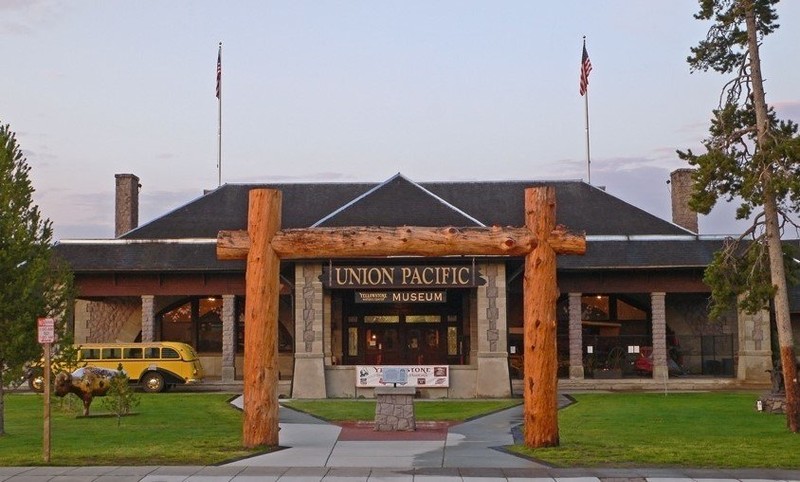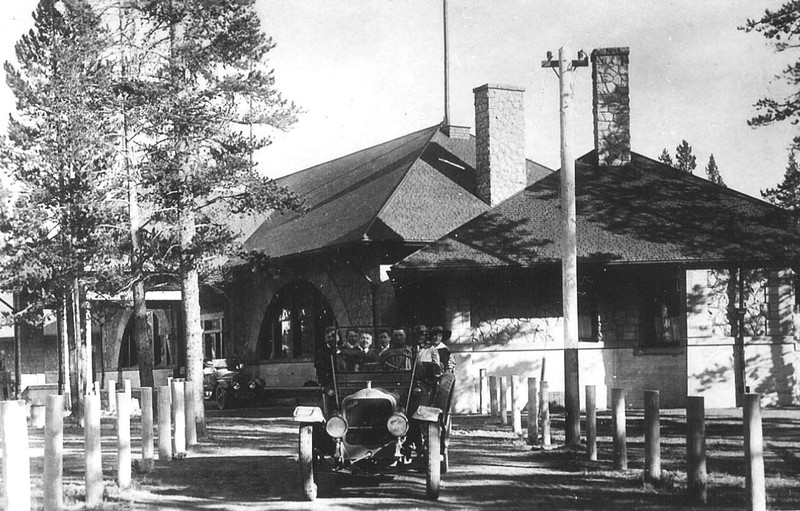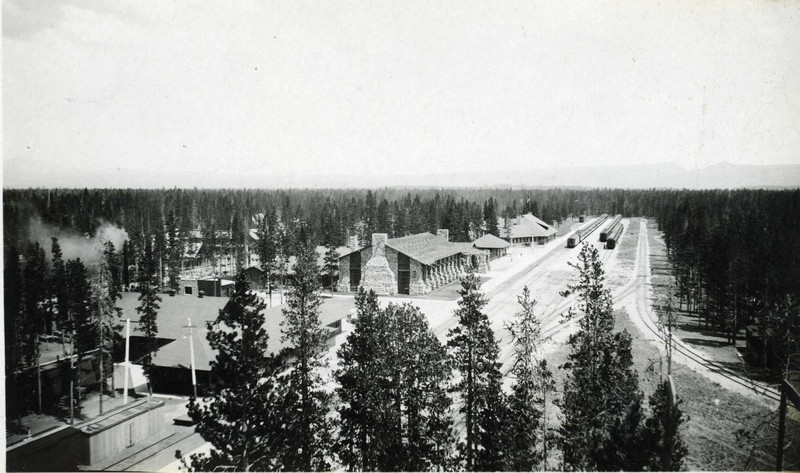Yellowstone Historic Center Museum (Former Union Pacific Depot)
Introduction
Text-to-speech Audio
Fascination with the Yellowstone area began with the first trappers' incredulous tales of gushing geysers and gurgling mud pots. Since being established as the world's first National Park in 1872, curious travelers have ventured from every corner of the world to experience this place called "Wonderland." Our museum, housed in the 1909 Union Pacific Depot, offers exhibits which interpret the heritage of travel to Yellowstone. The Museum features interactive displays, rare artifacts, weekly educational programs, guest speakers, daily films, and guided walking tours of the Union Pacific historic district. We invite you to join us when you visit West Yellowstone!
Images
Today, the old depot building is used to house the Yellowstone Historic Center Museum. In front of the museum sits a 1938 White Motor Model 706 bus, used as a tour bus in Yellowstone National Park.

A view of the front of the museum.

Historic photo of the depot with passengers all loaded up ready to tour Yellowstone National Park. This photo shows the west wing.

The depot is shown at the top in the row of buildings directly across the tracks from the trains.

Backstory and Context
Text-to-speech Audio
The Union Pacific Depot is the oldest remaining structure in West Yellowstone's Oregon Short Line Historic District. The depot was completed in 1909, replacing a temporary wooden structure that served as the depot in 1908. The station was designed by the Union Pacific Railroad's Engineering Office.
Soon after its construction, the Union Pacific described the depot as "built of stone, very substantial, spacious, and artistic. It is electric heated by steam, and provides large waiting rooms, an individual dressing room for ladies, two large fireplaces, drinking fountains, etc. In it are the usual ticket and Pullman offices and the office of the Monida and Yellowstone Stage Co. The trains approach on the south side while the stages receive and deliver passengers under the porte-cochere on the north side."
The Depot is a single-story, hip-roofed building, constructed of dimensional wood framing, brick, concrete, and quarry-faced native rhyolite stone. The stone came from nearby railroad right-of-ways. The central portion of the building measures 117 by 44 feet, while the east and west wings are 71 by 33 feet and 51 by 33 feet respectively.
The central part of the building included the waiting areas, the ticketing counters, and the porte-cochere. From the train platform, passengers entered the south side of the building through double doors into either the women's or the men's waiting rooms. Each of these rooms had a massive stone fireplace for heating. The waiting areas had wooden benches and large tables with chairs where passengers could scribe their letters and postcards. The ticket counter (which originally included the Monida and Yellowstone Stage Company office) and the telegraph office, a vestibule, and a news stand separated the two waiting rooms. Two sets of double doors led from the vestibule to the coach/bus loading platform.
The two "wings" of the building housed the dressing rooms and toilets. Private dressing rooms and showers were an unusual feature for a train depot. In West Yellowstone, they were necessary to accommodate the arriving train passengers who wanted to change from their train-travel clothing into stage-coach travel clothing. Coats, hats, and dusters were available at local vendors to rent for park travel. Passengers returning from the park could shower and change back into their "good" clothes for their return trip to Idaho and Salt Lake City.
Originally, the east wing of the depot served as the storage area for the passengers' excess baggage while they toured the park. By the early 1920s, the number of passengers had increased to the extent that the new Baggage Building was constructed and the east wing was converted to the Women's Dressing Room. That same year, the north porte-cochere was extended to cover the buses and provide room for the increasing number of travelers. The previous narrow porch made for a crowded line-up waiting for the stages and the subsequent buses. The concrete platform along the track was extended to the west to accommodate the longer trains.
Following the 1923 modifications, the building remained much the same, especially the exterior. In 1972, major changes were made throughout the depot to convert its use to a privately-operated museum. Especially significant was the removal of women's dressing rooms and toilets in the east wing of the building, as well as the removal of some of the dressing room partitions in the west wing. Many of the men's restroom facilities still remain today.
In 2000, the Yellowstone Historic Center leased the depot from the Town of West Yellowstone. The YHC spearheaded many major repair and restoration projects, including replacing the shingle roof, restoring interior features such as the ticket counter, repairing the ceilings, and upgrading electrical services and lines. The depot now is the home of the Yellowstone Historic Center Museum.
Soon after its construction, the Union Pacific described the depot as "built of stone, very substantial, spacious, and artistic. It is electric heated by steam, and provides large waiting rooms, an individual dressing room for ladies, two large fireplaces, drinking fountains, etc. In it are the usual ticket and Pullman offices and the office of the Monida and Yellowstone Stage Co. The trains approach on the south side while the stages receive and deliver passengers under the porte-cochere on the north side."
The Depot is a single-story, hip-roofed building, constructed of dimensional wood framing, brick, concrete, and quarry-faced native rhyolite stone. The stone came from nearby railroad right-of-ways. The central portion of the building measures 117 by 44 feet, while the east and west wings are 71 by 33 feet and 51 by 33 feet respectively.
The central part of the building included the waiting areas, the ticketing counters, and the porte-cochere. From the train platform, passengers entered the south side of the building through double doors into either the women's or the men's waiting rooms. Each of these rooms had a massive stone fireplace for heating. The waiting areas had wooden benches and large tables with chairs where passengers could scribe their letters and postcards. The ticket counter (which originally included the Monida and Yellowstone Stage Company office) and the telegraph office, a vestibule, and a news stand separated the two waiting rooms. Two sets of double doors led from the vestibule to the coach/bus loading platform.
The two "wings" of the building housed the dressing rooms and toilets. Private dressing rooms and showers were an unusual feature for a train depot. In West Yellowstone, they were necessary to accommodate the arriving train passengers who wanted to change from their train-travel clothing into stage-coach travel clothing. Coats, hats, and dusters were available at local vendors to rent for park travel. Passengers returning from the park could shower and change back into their "good" clothes for their return trip to Idaho and Salt Lake City.
Originally, the east wing of the depot served as the storage area for the passengers' excess baggage while they toured the park. By the early 1920s, the number of passengers had increased to the extent that the new Baggage Building was constructed and the east wing was converted to the Women's Dressing Room. That same year, the north porte-cochere was extended to cover the buses and provide room for the increasing number of travelers. The previous narrow porch made for a crowded line-up waiting for the stages and the subsequent buses. The concrete platform along the track was extended to the west to accommodate the longer trains.
Following the 1923 modifications, the building remained much the same, especially the exterior. In 1972, major changes were made throughout the depot to convert its use to a privately-operated museum. Especially significant was the removal of women's dressing rooms and toilets in the east wing of the building, as well as the removal of some of the dressing room partitions in the west wing. Many of the men's restroom facilities still remain today.
In 2000, the Yellowstone Historic Center leased the depot from the Town of West Yellowstone. The YHC spearheaded many major repair and restoration projects, including replacing the shingle roof, restoring interior features such as the ticket counter, repairing the ceilings, and upgrading electrical services and lines. The depot now is the home of the Yellowstone Historic Center Museum.
Sources
"The Union Pacific Depot." Yellowstone Historic Center. http://yellowstonehistoriccenter.org/Depot/ (Accessed November 2017).
A & E Architects, P.C. Historic Structures Report: Oregon Shortline. Missoula, MT, July 2001.
